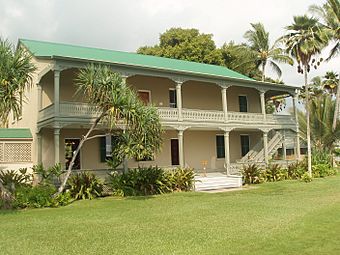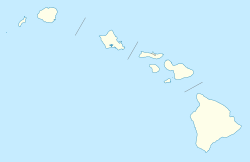Huliheʻe Palace facts for kids
Quick facts for kids |
|
|
Huliheʻe Palace
|
|
 |
|
| Location | 75-5718 Aliʻi Drive, Kailua-Kona, Hawaii |
|---|---|
| Area | 1 acre (0.40 ha) |
| Built | 1838 |
| Architect | John Adams Kuakini |
| NRHP reference No. | 73000653 |
| Added to NRHP | May 25, 1973 |
The Huliheʻe Palace is a historic building in Kailua-Kona, Hawaiʻi. It sits right on Ali'i Drive, a famous street. This beautiful palace was once a vacation home for Hawaiian royalty. Today, it is a museum run by the Daughters of Hawaiʻi. Inside, you can see old furniture and special items that belonged to the Hawaiian kings and queens.
Contents
The Palace's Story
Building the Palace
The Huliheʻe Palace was first built from lava rock. It was constructed around 1838 by John Adams Kuakini. He was the governor of the island of Hawaiʻi at that time.
Royal Owners Over Time
When Governor Kuakini passed away in 1844, he left the palace to his hānai son. A hānai son is like an adopted son in Hawaiian culture. This son was William Pitt Leleiohoku I. Sadly, Leleiohoku died in 1848 during a measles outbreak.
The palace then went to his son, John William Pitt Kīnaʻu. But Kīnaʻu also died young. So, the palace was passed to his mother, [[Keʻelikōlani|Princess Ruth Keʻelikōlani]].
Princess Ruth's Home
Princess Ruth Keʻelikōlani made Huliheʻe her main home for most of her life. Interestingly, she preferred to sleep in a traditional grass hut. This hut was located right on the palace grounds, instead of inside the palace itself.
Princess Ruth invited all the Hawaiian monarchs to vacation at Huliheʻe. These included kings and queens from Kamehameha III to Liliʻuokalani.
King Kalākaua's Changes
After Princess Ruth passed away, she left the palace to her cousin. This was Princess Bernice Pauahi Bishop. Later, the palace was sold to King Kalākaua and Queen Kapiʻolani.
King Kalākaua gave the palace a new name, Hikulani Hale. This means "House of the Seventh Ruler." He was the seventh monarch of the Hawaiian kingdom, which started with King Kamehameha I. In 1885, King Kalākaua had the outside of the palace covered with plaster. This made the building look more elegant and refined.
After King Kalākaua's death, the palace went to Queen Kapiʻolani. She then left Huliheʻe Palace to her two nephews. They were Prince [[Jonah Kūhiō Kalanianaʻole|Jonah Kūhiō Kalanianaʻole Piʻikoi]] and Prince David Kawānanakoa.
Becoming a Museum
In 1927, a special group called the Daughters of Hawaiʻi stepped in. This group works to protect the history and culture of the Hawaiian Islands. They worked with the government of the Territory of Hawaii and the palace caretaker, Stella Maude Jones.
Together, they restored Huliheʻe Palace. They turned it into a museum so everyone could learn about its royal past. The palace was officially added to the National Register of Historic Places listings on the island of Hawaii in 1973.
Earthquake Damage
In 2006, an earthquake hit the Kohala coast. The palace's walls and ceiling got small cracks from the shaking.
Images for kids
See also
 In Spanish: Palacio de Hulihee para niños
In Spanish: Palacio de Hulihee para niños













